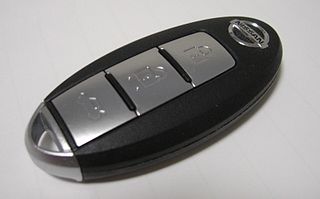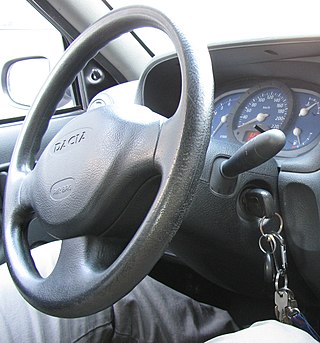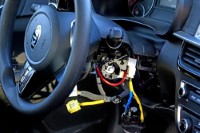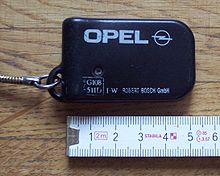
Motor vehicle theft is the criminal act of stealing or attempting to steal a motor vehicle. Nationwide in the United States in 2020, there were 810,400 vehicles reported stolen, up from 724,872 in 2019. Property losses due to motor vehicle theft in 2020 were estimated at $7.4 billion. There were 505,100 car thefts in the EU in 2019, a 43% decrease from 2008.

A catalytic converter is an exhaust emission control device which converts toxic gases and pollutants in exhaust gas from an internal combustion engine into less-toxic pollutants by catalyzing a redox reaction. Catalytic converters are usually used with internal combustion engines fueled by gasoline or diesel, including lean-burn engines, and sometimes on kerosene heaters and stoves.

A vehicle start-stop system or stop-start system automatically shuts down and restarts the internal combustion engine to reduce the amount of time the engine spends idling, thereby reducing fuel consumption and emissions. This is most advantageous for vehicles which spend significant amounts of time waiting at traffic lights or frequently come to a stop in traffic jams. Start-stop technology may become more common with more stringent government fuel economy and emissions regulations. This feature is present in hybrid electric vehicles, but has also appeared in vehicles which lack a hybrid electric powertrain. For non-electric vehicles fuel economy gains from this technology are typically in the range of 3–10%, potentially as high as 12%. In the United States, idling wastes approximately 14.8 billion liters of gasoline per year.

A car alarm is an electronic device installed in a vehicle in an attempt to discourage theft of the vehicle itself, its contents, or both. Car alarms work by emitting high-volume sound when the conditions necessary for triggering it are met. Such alarms may also cause the vehicle's headlights to flash, may notify the car's owner of the incident via a paging system, and may interrupt one or more electrical circuits necessary for the car to start. Although inexpensive to acquire and install, the effectiveness of such devices in deterring vehicle burglary or theft when their only effect is to emit sound appears to be negligible.
Hot-wiring is the process of bypassing a motor vehicle's ignition switch and thus starting it without the key. It is often utilized during a vehicle theft. However, a legitimate vehicle owner who has lost a vehicle key or starting a vehicle with inoperable ignition switch may also implement this process.

A smart key is an electronic access and authorization system that is available either as standard equipment or an option in several car designs. It was developed by Siemens in 1995 and introduced by Mercedes-Benz under the name "Keyless-Go" in 1998 on the W220 S-Class, after the design patent was filed by Daimler-Benz on May 17, 1997.
Anti-theft systems protect valuables such as vehicles and personal property like wallets, phones, and jewelry. They are also used in retail settings to protect merchandise in the form of security tags and labels. Anti-theft systems include devices such as locks and keys, RFID tags, and GPS locators.

The Kia K5, formerly known as the Kia Optima, is a mid-size car manufactured by Kia since 2000 and marketed globally through various nameplates. First generation cars were mostly marketed as the Optima, although the Kia Magentis name was used in Europe and Canada when sales began there in 2002. For the second-generation models, Kia used the Kia Lotze and Kia K5 name for the South Korean market, and the Magentis name globally, except in the United States, Canada, Malaysia and the Middle East, where the Optima name was retained until the 2021 model year. The K5 name is used for all markets since the introduction of the fifth generation in 2019.

A car key or an automobile key is a key used to open and/or start an automobile. Modern key designs are usually symmetrical, and some use grooves on both sides, rather than a cut edge, to actuate the lock. It has multiple uses for the automobile with which it was sold. A car key can open the doors, as well as start the ignition, open the glove compartment and also open the trunk (boot) of the car. Some cars come with an additional key known as a valet key that starts the ignition and opens the driver's side door, but prevents the valet from gaining access to valuables that are located in the trunk or the glove box. Some valet keys, particularly those to high-performance vehicles, go so far as to restrict the engine's power output to prevent joyriding. Recently, features such as coded immobilizers have been implemented in newer vehicles. More sophisticated systems make ignition dependent on electronic devices, rather than the mechanical keyswitch. A number of these systems, such as KeeLoq and Megamos Crypto have been demonstrated to be weak and vulnerable to cryptanalytic attacks.

A remote keyless system (RKS), also known as remote keyless entry (RKE) or remote central locking, is an electronic lock that controls access to a building or vehicle by using an electronic remote control (activated by a handheld device or automatically by proximity). RKS largely and quickly superseded keyless entry, a budding technology that restrictively bound locking and locking functions to vehicle-mounted keypads.

An engine control unit (ECU), also called an engine control module (ECM), is a device which controls multiple systems of an internal combustion engine in a single unit. Systems commonly controlled by an ECU include the fuel injection and ignition systems.
The Texas Instruments digital signature transponder (DST) is a cryptographically enabled radio-frequency identification (RFID) device used in a variety of wireless authentication applications. The largest deployments of the DST include the Exxon-Mobil Speedpass payment system, as well as a variety of vehicle immobilizer systems used in many late model Ford, Lincoln, Mercury, Toyota, Nissan, Kia, Hyundai and Tesla vehicles.
LoJack is a stolen vehicle recovery and IoT connected car system that utilizes GPS and cellular technology to locate users' vehicles, view trip history, see battery levels, track speeding, and maintain vehicle health via a native app. Prior to selling a vehicle, LoJack dealers can use the system to manage and locate inventory, view and manage battery health, and recover stolen inventory.

Joyriding is driving or riding in a stolen vehicle, most commonly a car, with no particular goal other than the pleasure or thrill of doing so or to impress other people. The term "joy riding" was coined by a New York judge in 1908.

An ignition switch, starter switch or start switch is a switch in the control system of a motor vehicle that activates the main electrical systems for the vehicle, including "accessories". In vehicles powered by internal combustion engines, the switch provides power to the starter solenoid and the ignition system components, and is frequently combined with the starter switch which activates the starter motor.
An anti-hijack system is an electronic system fitted to motor vehicles to deter criminals from hijacking them. Although these types of systems are becoming more common on newer cars, they have not caused a decrease in insurance premiums as they are not as widely known as other more common anti-theft systems such as alarms or steering locks. It can also be a part of an alarm or immobiliser system. An approved anti-hijacking system will achieve a safe, quick shutdown of the vehicle it is attached to. There are also mechanical anti-hijack devices.
SecuriLock, also known as Passive Anti-Theft System (PATS), is Ford Motor Company's immobilizer technology. In 1996 the technology started showing up on select models of Ford, Lincoln, and Mercury vehicles. The keys have a radio frequency transponder embedded in the plastic head with a unique electronic identification code.

Hyundai Motor America, doing business as Hyundai Motor North America is the operating subsidiary that oversees all operations of Hyundai Motor Company in Canada, Mexico, and the United States. Along with Hyundai's USA manufacturing plant in Montgomery, Alabama called Hyundai Motor Manufacturing Alabama, Hyundai has total of 19 manufacturing plants globally. Its operations include research and development, manufacturing, sales, marketing, after sales and corporate functions, which are controlled by HMA but sometimes executed by other subsidiaries and holding companies. The company is headquartered in Fountain Valley, California.
Automotive hacking is the exploitation of vulnerabilities within the software, hardware, and communication systems of automobiles.

The Kia Challenge is a viral TikTok trend to which a series of motor vehicle thefts is attributed, targeting Kia and Hyundai vehicles in the United States manufactured between 2011 and 2021. The trend, which began in October 2022, has led to eight fatalities, according to the National Highway Traffic Safety Administration.














